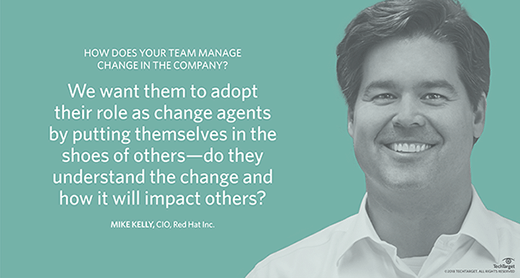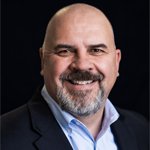Red Hat CIO talks open hybrid cloud, next-generation IT
Deploying his company's open hybrid cloud product, preparing for next-generation IT, building an 'inclusive meritocracy' -- Red Hat CIO Mike Kelly talks turkey with SearchCIO.
Mike Kelly joined Red Hat Inc. as CIO in August 2016, saying that he was drawn to the open source software vendor for what he calls its "open and uber-collaborative" culture and the opportunity to forge best practices for digital transformation.
Similar to 2018 plans of CIO colleagues at other companies, Kelly's list of priorities for the year include projects meant to move his organization off older technologies and onto more modern platforms.
"My responsibility is making sure the company runs as effectively as it can and that we're preparing ourselves for what we have today and for what's in the future," he said.
His list of priorities includes helping the company's global salesforce improve processes and systems; executing on plans for its data and analytics governance program as well as the cybersecurity program; and realizing the benefits of open hybrid cloud using Red Hat's own technologies.
Here he speaks about the opportunities and challenges he has in leading his IT team of 500 associates as it provides the technology used by Red Hat's 11,500 or so worldwide employees.
You're a tech company, but you still have legacy IT systems?
Mike Kelly: Red Hat has been around since 1993. We're not a digital native, and that plays to our strategy for our open hybrid cloud. We believe that's the future. My world is quite similar to other CIOs whose companies have been around for a while.
So, open hybrid cloud is your future, I'm guessing?
Kelly: That's our company's core strategy: embracing the open hybrid cloud. We believe IT organizations are going to operate over four footprints: on-premises bare metal, on-premises virtualized, private cloud and public cloud. We do not believe that a company is going to make a large-scale binary shift from on-premises to the public cloud; we don't believe that's going to be the lion's share. Our OpenShift Container Platform allows you to operate seamlessly over those four footprints, and we believe that by building in containers, [companies] have portability across those four footprints.

How do you evaluate your legacy IT and determine what should be modernized?
Kelly: If we have an asset on the books and if we're going to replace that, we have to make sure that the value we get out of the new solution can either ideally offset that existing cost or at least get us further along so we feel better about the environment. Others are around features and functions [and whether] we feel there's going to be a positive associate experience with the new app versus the one we have.
Solving for cloud
What's the biggest challenge you face moving to open hybrid cloud?
Kelly: There's no one single roadblock that exists for the journey, which is ongoing. But the biggest hurdle is one of people, to have your people ready with the skills needed for this. We looked at this and asked: What are the types of skills we need resident in our team to live in this world? Do we want to hire people or leverage contractors? Then we built some programs around efforts to upskill our people; it's incumbent on us to help them learn skills. But we had a mix of all three [new hires, contractors and upskilled staff]. I don't think it's pragmatic to think you can do one versus the other. I think you need to think all three of those. [On the other hand] just giving it to a provider saying, 'Go figure this out,' is a recipe for disaster. You have to stay very engaged.
What are your long-range tech goals?
Kelly: The mission of my team is to be next-generation IT. We want to be representative of what we're telling our customers is the right thing to do. That's a mix of old and new. We have to focus on running the day-to-day in an operationally excellent way, and we also have to have an eye toward the future and do that in an operationally excellent way as well. And because we're talking about IT all day at Red Hat, it makes it a lot of fun.
Next-generation IT
What do you see as next-generation IT?
Kelly: In many companies for a very long time, the highest levels of the company have said IT is not our core competency, so we want this function to be highly reliable at the lowest cost possible. So, the CIO said, 'I have to stay as operationally excellent as possible at the lowest cost possible.' As a result of that, [CIOs] took certain steps like outsourcing staff to lower-cost providers, etc., and that was what success looked like. Now, every company is a technology company, so success is paying homage to the past by providing high reliability and optimizing cost but also utilizing technology to differentiate. So, next-generation IT is enabling that type of environment and still taking care of the classic ways IT is known.
How do you build an IT team that will get you there?
Kelly: When I arrived, I had a really strong team in place. So, for me as the new leader, it was important to listen to what makes them tick and then thinking about how I could insert my own special ingredients into that. But what sustains it is paying hyper attention to what's important and listening and making sure we're doing what we're saying. To me, personally, that means being uber authentic and being open and being engaged with the team to help them feel like they're bigger working together than what they could be on their own.
The right IT stuff
But what are the skills you want in your team?
Kelly: and foremost, I want people who are balanced in their approach to that which we do today and that which we need to do tomorrow. Calculated risk-takers, idea people but rooted in pragmatic approaches to things. Buying into our idea that there is always a better way, whether through continual improvement or operational excellence. That's the mindset I'd like to have on the team.
What is your biggest challenge for the upcoming year?
Kelly: It's a great time to be in IT and there's no shortage of opportunities and exciting things happening. But it's daunting to keep pace with all the great things happening, So, it's focus, it's how do you take all these things happening and distill them down into a that's durable and has the ability to change.
How do you evaluate all the 'opportunities and exciting things happening' and determine what is worth your team's focus?
Kelly: I use our purpose and operating principles to look for things that we should be doing. We use those to set plans and, once we start to execute them, we constantly question them. For coming in with things like blockchain, the question we ask is: How do we apply this to what we're doing? I have a strategy and enablement function on my team that's supposed to lead that effort, but I ask all my associates to stay current. And I spent a lot of time in the venture community, with private equity folks and my CIO network to hear what they're doing and asking if there are more important things out there that we need to focus on.
IT culture
How do you describe the IT team culture?
Kelly: We have an inclusive meritocracy. I have direct reports and a leadership team, but they're not responsible for dictating what we're going to do. We have a very open, collaborative process where we engage everybody in our and our execution process. It's in lockstep with Red Hat's culture.
I would say, though, too, that part of that is very purpose-driven. When I came on board, we had an open forum to solicit feedback on this, and we came up with a purpose and we landed on what our strategic areas of focus are. We believe that if people are bought into the vision, they'll stay. We absolutely have to compete for talent, but it's a bigger issue than the IT team. It's about feeling attracted to the mission and that they can contribute. That's our biggest retention strategy.
Are you ever in competition for talent with the product side team at your own company?
Kelly: Internally, I would say it is co-opetition. We want everyone in our company to have a fulfilling career path and a diverse experience in many parts of the company.








